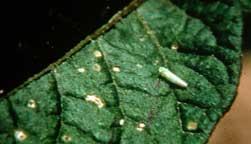
The carrots infected with aster yellows tend to develop many hairy roots, become stunted, and turn pale.
In lettuce, yellowing of the infected plants, stunting and twisting of the leaves characterize it.
Potato leafhopper is a mid to late season pest. The adult and nymphs destroy the tissues where manufactured food from the leaves is transported to other parts of the plant. The attacked leaves turn yellow and roll. These symptoms are referred to as "Hopperburn". Yield loss can occur at relatively low populations and before the symptoms are visible.
Monitor aster leafhoppers by using yellow sticky traps positioned above the crop canopy and spray insecticides recommended in your state when 5-10 leafhoppers per field are trapped on yellow sticky cards. Use row covers, reflective mulch, and elimination of weeds that are alternate hosts to aster leafhopper. Potato leafhoppers can be controlled by application of foliar and soil applied insecticides recommended in your state.